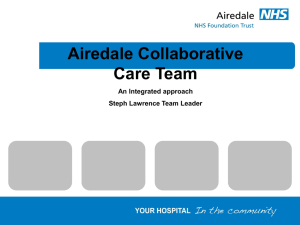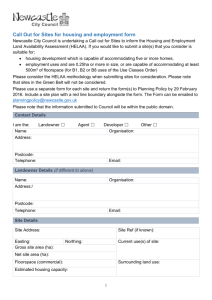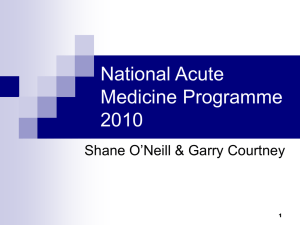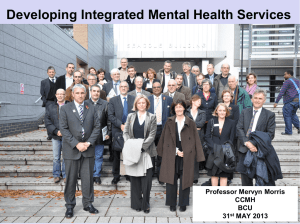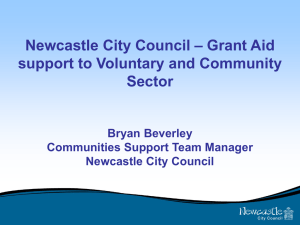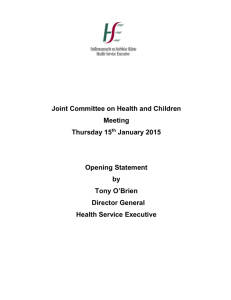yesterday – the asylums - Capital Projects and Service Planning
advertisement
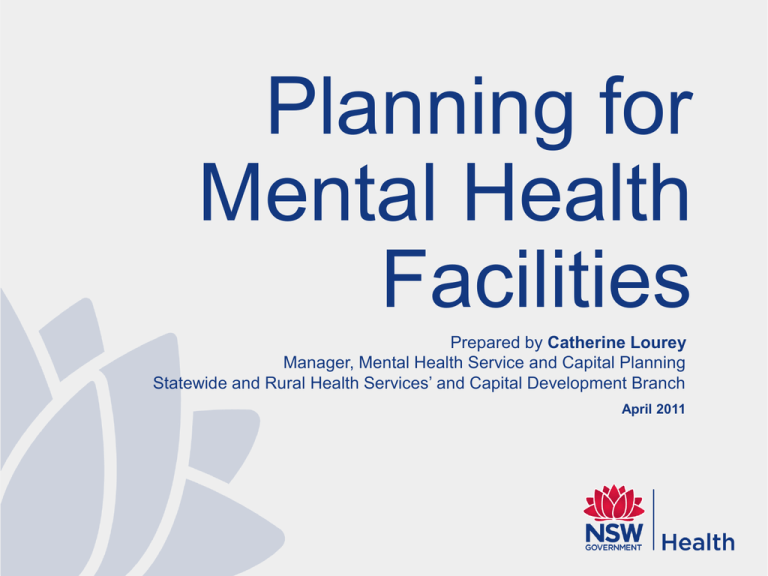
Planning for Mental Health Facilities Prepared by Catherine Lourey Manager, Mental Health Service and Capital Planning Statewide and Rural Health Services’ and Capital Development Branch April 2011 Cumberland Hospital Themes Yesterday - The 1800s and 1900s asylums Today – Integration in the 21st century Tomorrow - Planning drivers for change Emerging planning issues Lunatic Reception House, Darlinghurst Sydney 1800’s YESTERDAY – THE ASYLUMS Yesterday: The 1800s asylums • The first asylum at Tarban Creek, Gladesville for 80 patients in 1838, growing to 642 by 1876 • By 1855 a second asylum had been built at Parramatta, with 279 patients • In 1871 the Newcastle Psychiatric Hospital was opened with 120 patients • In 1879 Callan Park Asylum at Rozelle was built, for 666 patients • Followed by the Rydalmere Asylum in 1888, to close 100 years later. Gladesville Hospital ward By the early 1880s psychiatric outpatient clinics had been established nine hospitals: – Royal Prince Alfred; Sydney; St Vincent’s; Lewisham; North Shore; Parramatta; Newcastle; Goulburn and Orange. Parramatta Hospital for the Insane The 1900s: from asylum to integration Four new rural hospitals: – Kenmore Hospital in 1901 503 patients growing to 1,107 in 1962; – Morisset Hospital in 1909, 78 patients growing to 1,403 in the 1960s, – Stockton Hospital in 1910 and Bloomfield Hospital at Orange in 1924 Finally followed by Macquarie Hospital at North Ryde in 1959 for 1,400 patients Recasting the Service Paradigm James Fletcher Hospital Newcastle In 1901 there were 4,423 inpatients in NSW psychiatric hospitals By 1958 there were 13,761 inpatients. By 1990 there were 2,864 inpatients The model of care paradigm had been recast: – Expansion of community mental health – New pharmacological therapies supported shorter hospital stays and patients living in the community – New mental health units on general hospitals: at RNSH in 1965 of 28 beds, Westmead Hospital in 1978 of 22 beds INTEGRATION IN THE 21ST CENTURY Directions for the 21st century – Expanding new models of care e.g. youth services, PECCs Young Adult Mental Health Unit, Campbelltown Hospital. – Provision of specialist inpatient services e.g. Child & Adolescent, Mental Health ICU – Leaving the stand alone psychiatric hospitals behind – Strengthening the forensic mental health service – Collaborative role with the NGO sector in community based rehabilitation services (HASI) – Facilities which are more conducive to the care and treatment of the mentally ill Mainstreaming of services Relocating the stand alone mental health facilities on general hospital campuses – Rozelle Hospital to Concord Hospital 174 beds in 2008 – James Fletcher at Mater Health Newcastle 100 beds in 2009 – Bloomfield integrated with Orange Hospital 218 beds in 2011 Mater Mental Health, Newcastle From inmates to inpatients Relocating the forensic hospital from the State Corrections Service to the Forensic LHN with a purpose built 135 bed hospital (2008). Integrated units Developing co-located mental health inpatient services on general hospital sites such as: - Liverpool 50 bed unit; Lismore 40 adult and 8 C&A beds; Caritas 27 bed acute unit - New tertiary mental health units within each of the two campuses of the Sydney Children's Hospital Network Hall Ward – CAMHS Unit, Westmead Children’s Hospital Nexus C&A Unit, Newcastle A responsive service mix Recovery model focus – development of five 20 bed non acute rehabilitation units, plus two state-wide specialist non acute secure units including one for forensic clients Services across the life span – new older persons mental health units at Wyong, Wollongong and Bloomfield; five new child and adolescent units, with two currently in construction; young adult unit Campbelltown Balance hospital focussed care – new C&A day program units at Shellharbour, Orange; new older persons day program planned in the new Nepean mental health development; new community health facilities at Liverpool, Sutherland and Lismore Networking of services Liverpool Hospital Mental Health Centre Feb 2006 – 50 acute beds and community mental health. Light filled corridor Bedroom Community health Lecture room One Courtyard Dubbo Hospital Acute Unit THE PLANNING DRIVERS FOR CHANGE National and State Plans The Fourth National Mental Health Plan Priority Area 3 Service access, coordination and continuity of care: “Develop a national service planning framework that establishes targets for the mix and level of the full range of mental health services, backed by innovative funding models.” The NSW State Plan priorities include: “Improved outcomes in mental health.” State Health Plan Mental health priorities and directions for – – Improve awareness, prevention, early identification and detection of mental illness, especially of people at risk, including children and adolescents. – Cross sector working with non-government and private providers, and Commonwealth programs, to improve integration – Improving treatment services to better respond to the onset of mental illness. – Improving emergency health responses A New Direction for Mental Health 2006 This plan’s direction is significant in that for the first time it aims to balance hospital focused care with community care. A $939 million program of additional expenditure to be implemented over five years, comprising: – $601 million in recurrent funding, of which $279 million was for community based care – $338 million in capital works, including additional funding for new capital works, works-in-progress, and privately financed projects. State Mental Health Planning Tool The Mental Health Clinical Care and Prevention (MH-CCP) model is a population-based planning model for mental health services, published and endorsed in 2002. It uses assumptions about the prevalence of mental disorders and the packages of care needed for those disorders to estimate the resources (community staff, acute beds, non-acute beds) required to meet the specialist mental health care needs of a population. The MH-CCP model has been revised over the past 12 months, with an updated version soon to be finalised. EMERGING PLANNING ISSUES Mental Health Service Planning Priorities Services closer to home: New units in population growth zones - Campbelltown, Nepean, Shellharbour; in rural areas Broken Hill, Dubbo, Orange, Goulburn, Lismore, Bega Expansion of integrated specialist services: mental health intensive care units at Hornsby, Orange and in construction at Prince of Wales; five C&A units; five non acute units Development of new models of care: 12 Psychiatric Emergency Care Centres; a tertiary rehabilitation adolescent unit; seven sub acute units in planning; young adult services Engagement of the NGO sector: Housing And Support Initiative started in 2002/03 with 100 high support consumers, now delivers services to 1135 consumers. Emerging planning issues Multi storey mental health facilities – can they be safe and afford patients space and light? Agility - in philosophy; building design, staff skill and mix to take advantage of contemporary and new models of care Mainstreaming inpatient services – principles for locating mental health units; for providing ECT services; for locating community mental health Responsive to changes patterns in demand - emerging co-morbidities, earlier onset, ageing Commonwealth sub acute mental health projects – new service models And as health planners ... Support mainstreaming, recovery and patient centeredness in our policies, building design and service plans Advise on the service/capital interface to ensure/promote effective built solutions which support optimal care and health outcomes Continue to engage with all stakeholders: consumers and carers; clinicians across disciplines; service providers in the inpatient, community health, non government sector and private sectors Increase service evaluation and use of evidence based planning Thank you, Broughton Hall Hairdressing Salon 1957
